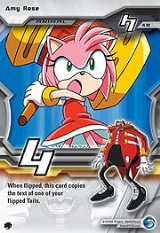
Sonic X Trading Card Game
Encyclopedia
The Sonic X Trading Card Game is an introductory-level trading card game based on the Sonic the Hedgehog
video game property from Sega
. The card game, from Score Entertainment
, debuted in August 2005.
It is worth noting that the actual text on the card itself may cause further discards or otherwise have further instructions (e.g. "When flipped, you may discard an opposing blue card").
Hence, the primary play strategy has to do with the arrangement of cards (particularly against the cards of an opponent's next spare row, which is known from the previous turn), and with the order in which cards are revealed.
Cards can only be purchased in booster pack
s, which contain 10 cards each. Thus, a minimum of 3 booster packs is needed in order to build a playable deck, although because there are no cards of differing types, it is quite likely that these will be sufficient in order to build a basic deck.
Sonic the Hedgehog (16-bit)
is a seminal 16-bit 1991 platform video game developed in Japan by Sega and published for the Sega Genesis. It is the first installment in Sega's flagship Sonic the Hedgehog video game series and the first title developed by Sonic Team. The game was released in 1991 in North America, Europe, and...
video game property from Sega
Sega
, usually styled as SEGA, is a multinational video game software developer and an arcade software and hardware development company headquartered in Ōta, Tokyo, Japan, with various offices around the world...
. The card game, from Score Entertainment
Score Entertainment
Score Entertainment was a trading card design and manufacturing company based in Arlington, Texas. Their first card game was the Dragon Ball Z: Collectible Card Game in 2000. Score Entertainment was a member of the Donruss Playoff LP family of companies...
, debuted in August 2005.
Card elements
- Title - The title of the card, used for uniqueness purposes when constructing a deck and referred to by certain other cards.
- Traits - Keywords underneath the title which other card effects may act upon. The base traits are Animal, Human, Place, Robot, and Thing.
- Color - Cards can be blue, red, yellow or gray in color.
- Number Key - Information for collectability purposes, including the card number and rarity, which appears in the upper right corner.
- Rings - The large number on the card which represents the number of rings associated with that card.
- Text - The actual text near the bottom of the card which causes game effects.
Discards
As cards are revealed during the Rush Step, the act of flipping over the card may cause the opposing player to discard cards from the card grid. This is based on two discard rules:- Copy Discards - When a card is turned face-up, if the opponent has any face-up cards (anywhere in either of the two rows) which have both the same color and the same number of rings, these cards must be discarded.
- Battle Discards - When a card is turned face-up, if the opponent has any face-up cards of the same color in the same column, check the number of rings on those cards. If a rivel's card has more rings than the card just revealed, it must be discarded. Note that there is a limit on one discard at a time triggered in this fashion (i.e. flipping one card face-up cannot cause a Battle Discard from both the opponent's spare row and chaos row at the same time).
It is worth noting that the actual text on the card itself may cause further discards or otherwise have further instructions (e.g. "When flipped, you may discard an opposing blue card").
Hence, the primary play strategy has to do with the arrangement of cards (particularly against the cards of an opponent's next spare row, which is known from the previous turn), and with the order in which cards are revealed.
Decks and cards
Each player must provide a deck with at least 30 cards. There is a limit of 5 copies of any single card per deck.Cards can only be purchased in booster pack
Booster pack
In collectible card games and collectible miniature wargames, a booster pack is a sealed package of cards or figurines, designed to add to a player's collection....
s, which contain 10 cards each. Thus, a minimum of 3 booster packs is needed in order to build a playable deck, although because there are no cards of differing types, it is quite likely that these will be sufficient in order to build a basic deck.

